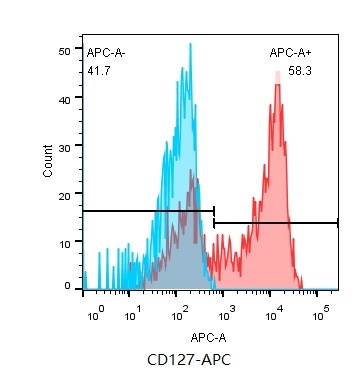
Mouse Anti-human CD127-APC antibody
IL-7Rα; IL-7Ra; Interleukin-7 receptor subunit alpha; CD 127; CD127; CD127 antigen; CDW127; IL 7R alpha; IL 7R; IL-7 receptor subunit alpha; IL-7R subunit alpha; IL-7R-alpha; IL7RA; IL7Ralpha; Interleukin 7 receptor alpha chain; Interleukin 7 receptor; In
View History [Clear]
Details
Product Name human CD127-APC Chinese Name APC标记人CD127单克隆抗体 Alias IL-7Rα; IL-7Ra; Interleukin-7 receptor subunit alpha; CD 127; CD127; CD127 antigen; CDW127; IL 7R alpha; IL 7R; IL-7 receptor subunit alpha; IL-7R subunit alpha; IL-7R-alpha; IL7RA; IL7Ralpha; Interleukin 7 receptor alpha chain; Interleukin 7 receptor; Interleukin 7 receptor isoform H5 6; IL7RA_HUMAN. Research Area Cell biology immunology Developmental biology Stem cells lymphocyte t-lymphocyte b-lymphocyte Immunogen Species Mouse Clonality Monoclonal Clone NO. A019D5 React Species Human, Applications Flow-Cyt=5ul/Test
not yet tested in other applications.
optimal dilutions/concentrations should be determined by the end user.Theoretical molecular weight 50kDa Cellular localization The cell membrane Secretory protein Form Liquid immunogen NULL Lsotype IgG1 Purification affinity purified by Protein G Buffer Solution 0.01M PBS, 0.2%BSA, 0.03%Proclin300. Storage Store at 2-8℃ for one year. Avoid repeated freeze/thaw cycles. Attention This product as supplied is intended for research use only, not for use in human, therapeutic or diagnostic applications. PubMed PubMed Product Detail Interleukin 7 Receptor alpha (IL-7RA), also known as CD127, is a 75 kDa hematopoietic receptor superfamily member that plays an important role in lymphocyte differentiation, proliferation, and survival. IL-7 receptor alpha (CD127) signaling is essential for T-cell development and regulation of naive and memory T-cell homeostasis. IL-7RA is critically required for the proper development and function of lymphoid cells. Therefore, the IL-7RA is critically required for the proper development and function of lymphoid cells.
Function:
Receptor for interleukin-7. Also acts as a receptor for thymic stromal lymphopoietin (TSLP).
Subcellular Location:
Secreted and Cell membrane.
Post-translational modifications:
N-glycosylated IL-7Ralpha binds IL7 300-fold more tightly than the unglycosylated form.
DISEASE:
Defects in IL7R are a cause of severe combined immunodeficiency autosomal recessive T-cell-negative/B-cell-positive/NK-cell-positive (T(-)B(+)NK(+) SCID) [MIM:608971]. A form of severe combined immunodeficiency (SCID), a genetically and clinically heterogeneous group of rare congenital disorders characterized by impairment of both humoral and cell-mediated immunity, leukopenia, and low or absent antibody levels. Patients present in infancy recurrent, persistent infections by opportunistic organisms. The common characteristic of all types of SCID is absence of T-cell-mediated cellular immunity due to a defect in T-cell development.
Genetic variations in IL7R are a cause of susceptibility to multiple sclerosis type 3 (MS3) [MIM:612595]. A multifactorial, inflammatory, demyelinating disease of the central nervous system. Sclerotic lesions are characterized by perivascular infiltration of monocytes and lymphocytes and appear as indurated areas in pathologic specimens (sclerosis in plaques). The pathological mechanism is regarded as an autoimmune attack of the myelin sheat, mediated by both cellular and humoral immunity. Clinical manifestations include visual loss, extra-ocular movement disorders, paresthesias, loss of sensation, weakness, dysarthria, spasticity, ataxia and bladder dysfunction. Genetic and environmental factors influence susceptibility to the disease. Note=A polymorphism at position 244 strongly influences susceptibility to multiple sclerosis. Overtransmission of the major 'C' allele coding for Thr-244 is detected in offspring affected with multiple sclerosis. In vitro analysis of transcripts from minigenes containing either 'C' allele (Thr-244) or 'T' allele (Ile-244) shows that the 'C' allele results in an approximately two-fold increase in the skipping of exon 6, leading to increased production of a soluble form of IL7R. Thus, the multiple sclerosis associated 'C' risk allele of IL7R would probably decrease membrane-bound expression of IL7R. As this risk allele is common in the general population, some additional triggers are probably required for the development and progression of MS.
Similarity:
Belongs to the type I cytokine receptor family. Type 4 subfamily.
Contains 1 fibronectin type-III domain.
SWISS:
P16871
Gene ID:
3575
Database links:Entrez Gene: 3575 Human
Omim: 146661 Human
SwissProt: P16871 Human
Unigene: 591742 Human
Product Picture
References (0)
No References
Bought notes(bought amounts latest0)
No one bought this product
User Comment(Total0User Comment Num)
- No comment



 +86 571 56623320
+86 571 56623320
 +86 18668110335
+86 18668110335

